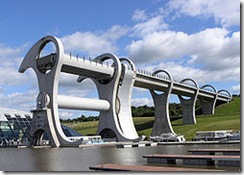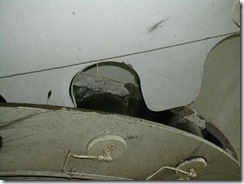What are the horns for?
(Technology of a different sort today, just for a change of pace.)
 The first time I saw a picture of the Falkirk Wheel -- the world's only rotating boat lift, in Scotland -- I thought that it must be a really nice computer-generated landscape. It looks like something you'd see in Halo.
The first time I saw a picture of the Falkirk Wheel -- the world's only rotating boat lift, in Scotland -- I thought that it must be a really nice computer-generated landscape. It looks like something you'd see in Halo.
But it's real; it lifts and lowers boats 24 metres between two canals. I was first sent photos of it by some engineer friends of mine, and we got into an email discussion of some of the interesting points in the design and implementation of such a device.
First off, does the weight of the boats in the rotating caissons matter? What if one caisson has a lot of heavy boats and the other has only light boats -- won't the imbalance put extra stress on the structure and the gears?
No! Boats displace their own weight in water -- at least, boats that still float do. Therefore when a boat of any tonnage enters a caisson, a mass of water equal to the mass of the boat leaves. As long as both caissons have the same volume and are filled to the same height, they always have the same mass no matter what boats are in them.
This means that it is straightforward to keep the imbalance between the two sides pretty small, just by using pumps to ensure that each caisson is filled to the same height. Because the system is so well balanced, and takes a good seven minutes to rotate, the power requirements are surprisingly low. In the six-to-twelve kilowatts range, which is only about one hundred bright light bulbs. (People are often surprised by how little power it takes to slowly rotate something balanced. For example, apparently the motor that powers the rotating restaurant in the Space Needle is a one-horsepower motor with a huge gear ratio.)
 We then got into a lively discussion of what the horns on the sides of the Wheel rotor are for. One of my engineer friends thought that one of the horns might be deliberately heavier than the other, the resulting torque providing some mitigation of the "play" or "backlash" inherent in all gearing systems. But as you can see if you look carefully in the photo, the designers of the Wheel came up with a different solution to mitigate backlash in the planetary gears. The "teeth" of the lower gear are actually rollers. The gears fit together the same way that a bicycle sprocket fits the rollers in the chain. Neat!
We then got into a lively discussion of what the horns on the sides of the Wheel rotor are for. One of my engineer friends thought that one of the horns might be deliberately heavier than the other, the resulting torque providing some mitigation of the "play" or "backlash" inherent in all gearing systems. But as you can see if you look carefully in the photo, the designers of the Wheel came up with a different solution to mitigate backlash in the planetary gears. The "teeth" of the lower gear are actually rollers. The gears fit together the same way that a bicycle sprocket fits the rollers in the chain. Neat!
This still doesn't explain what the horns are for. After lots more speculation I decided to cut to the chase and emailed the public relations people at the Wheel. They cheerfully informed me that the horns were entirely decorative, served no engineering purpose, and were designed to be reminiscent of Celtic-style axes.
I don't believe them. I know what the horns are for. I mean, think about it. When the descending side of the Wheel strikes the water, the sharp horn breaks the surface tension and allows the rest of the rotor to smoothly enter the pool below. That's the only sensible explanation.
(Wikimedia Commons photo by Sean Mack, gear photo by James Gentles.)
Comments
Anonymous
March 05, 2009
Thanks for the interesting diversion, but I don't believe your theory holds any water. If the surface tension really needed to be broken, then wouldn't it need to be broken the entire length of the caisson? Won't the entire caission splash down when it hits the water? Obviously the horns are to warn the fish.Anonymous
March 05, 2009
Brilliant! Tragically, of course the horns do not ever enter the water at all -- the Wheel rotates into a dry dock which then connects the caisson to the pool. Another couple of beautiful theories spoiled by facts.Anonymous
March 05, 2009
We spent an entire afternoon at the Falkirk Wheel a few years back. It's amazing to watch the canal boats enter the caissons, rotate to the top, and continue on their journey. The whole process is quiet, efficient, and truly leaves you impressed by the power of good engineering minds.Anonymous
March 05, 2009
Wow. This reminded me of the http://en.wikipedia.org/wiki/Magdeburg_Water_BridgeAnonymous
March 05, 2009
The comment has been removedAnonymous
March 05, 2009
"They cheerfully informed me that the horns were entirely decorative, served no engineering purpose, and were designed to be reminiscent of Celtic-style axes." Lies ... the horns are a clear indication that the device has a hidden purpose, to create a temporal vortex by spinning counter clockwise and open a temporal tunnel to the past. They plan to use it to go back in time and change history ... The boat lift certainly looks like it was pulled out from a science-fiction novel more than it's an engineered device from our age. Thanks Eric, that was a great read and great find.Anonymous
March 06, 2009
Due to gravity, wouldn't the wheel only be balanced when the caissons are perfectly aligned either vertically or horizontally? I am not following your train of thought here at all. Can you explain? -- EricAnonymous
March 06, 2009
Chris, it would always be balanced from the engine's perspective. When the caissons are at any degree, the amount of radial force (hope I'm using the right term here) would be the same and in inverse directions for both caissons, balancing out. The centripetal/centrifugal force, however would be different - the caisson at the top would push into the center, the caisson at the top would pull out. But these forces don't matter to the engine, they are countered by the actual structure that holds the caissons together. A "radial force" -- that is, a force which attempts to rotate an object by applying a force a certain distance from an axle -- is usually called a "torque". -- EricAnonymous
March 06, 2009
Also, it rotates the other way. Look it up on YouTube. The Wheel rotates counter-clockwise as seen from the pool. So it rotates towards the horns. -- EricAnonymous
March 13, 2009
The caissons do not enter the pool below at all. There is a "dry dock" void below the wheel Yes, I know. I was indulging in a humourous japery. -- Eric